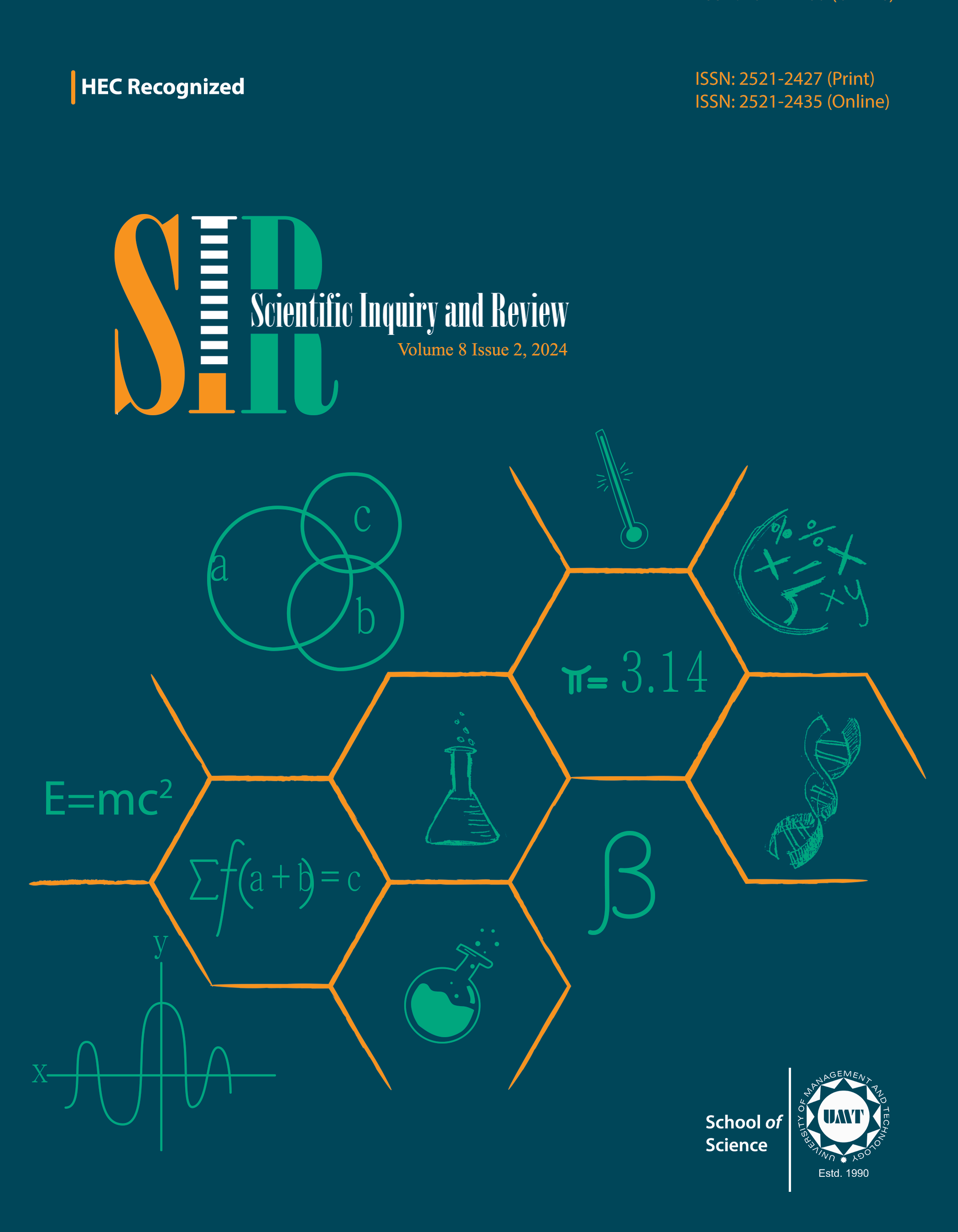Antioxidant and Anticancer Activity of Tannins Isolated from Callus Cultures of Achyranthes aspera L.
Abstract
 Abstract Views: 0
Abstract Views: 0
In the current study, the impact of oxidative stress induced by free radicals generated during metabolic processes was investigated. It was found to be linked to a variety of diseases due to their detrimental effects on nucleic acids and proteins. The primary focus remained on investigating the free radical-scavenging properties and potential anticancer activities of tannins found in callus cultures of A. aspera. It was observed that the induction of callus formation was notably successful when using leaf and root explants, resulting in a callus index as high as 160, as compared to stem explants in the presence of auxins. The extraction yield of callus tannins was the most abundant in chloroform extracts, although the overall antioxidant activity was comparable among chloroform, methanol, and petroleum ether callus extracts. Among these extracts, the chloroform extract from stem callus cultures grown on the MSDN medium showed the highest total antioxidant activity. Notably, tannins extracted from A. aspera leaf callus extracts displayed significant anticancer effects against the Jurket cell line. These effects were evaluated through measures such as cell viability and colony formation. The anticancer activity was notably higher in callus culture extracts as compared to the control. In summary, the results showed that in vitro biomass production can be a valuable approach for augmenting the production of bioactive compounds, such as tannins, from selected medicinal plants including A. aspera. Tannins extracted from A. aspera hold promise for their potential role in the development of new medicines.
Downloads
References
Dawidowicz AL, Wianowska D, Baraniak B. The antioxidant properties of alcoholic extracts from Sambucus nigra L. (antioxidant properties of extracts). LWT-Food Sci Technol. 2006;39(3):308–315. https://doi.org/10.1016/j.lwt.2005.01.005
Baer-Dubowska W, Szaefer H, Majchrzak-Celińska A, Krajka-Kuźniak V. Tannic acid: specific form of tannins in cancer chemoprevention and therapy-old and new applications. Curr Pharmacol Rep. 2020;6:28–37. https://doi.org/10.1007/s40495-020-00211-y
Jamshidi-Kia F, Lorigooini Z, Amini-Khoei H. Medicinal plants: past history and future perspective. J Herbmed Pharmacol. 2018;7:1–7.
Huang MY, Zhang LL, Ding J, Lu JJ. Anticancer drug discovery from Chinese medicinal herbs. Chin Med. 2018;13:e35. https://doi.org/10.1186/s13020-018-0192-y
Barros L, Oliveira S, Carvalho AM, Ferreira IC. In vitro antioxidant properties and characterization in nutrients and phytochemicals of six medicinal plants from the Portuguese folk medicine. Ind Crops Prod. 2010;32(3):572–579. https://doi.org/10.1016/j.indcrop.2010.07.012
Gazel M, Hemmati C, Bhat AI, Rao GP. Update on phytoplasma diseases associated with medicinal plants and spices in Asian Countries. In Tiwari AK, Caglayan K, Hoat TX, Subhi AA, Nejat N, Reddy G, eds. Phytoplasma Diseases of Major Crops, Trees, and Weeds. Elsevier; 2023:233–263.
Chandran H, Meena M, Barupal T, Sharma K. Plant tissue culture as a perpetual source for production of industrially important bioactive compounds. Biotechnol Rep. 2020;26:e00450. https://doi.org/10.1016/j.btre.2020.e00450
Phaniendra A, Jestadi DB, Periyasamy L. Free radicals: properties, sources, targets, and their implication in various diseases. Ind J Clin Biochem. 2015;30:11–26. https://doi.org/10.1007/s12291-014-0446-0
Pourmorad F, Hosseinimehr S, Shahabimajd N. Antioxidant activity, phenol and flavonoid contents of some selected Iranian medicinal plants. Af J Biotechnol. 2006;5(11):1142–1145.
Tanveer H, Safdar A, Asi MR. Appraisal of an important flavonoid, quercetin, in callus cultures of Citrullus colocynthis. Int J Agric Biol. 2012;14(4):1814–9596.
Murashige T, Skoog F. A revised medium for rapid growth and bioassays with tobacco tissue cultures. Physiol Plant. 1962;15(3):473–497.
Prieto P, Pineda M, Aguilar M. Spectrophotometric quantitation of antioxidant capacity through the formation of a phosphomolybdenum complex: specific application to the determination of vitamin E. Anal Biochem.1999;269(2):337–341. https://doi.org/10.1006/abio.1999.4019
Orellana EA, Kasinski AL. Sulforhodamine B (SRB) assay in cell culture to investigate cell proliferation. Bio Protoco. 2016;6(21):e1984.
Wood HN, Alves LM, Sterner R, Basile DV. Auxin-phorbol ester: an example of a two-stage initiation-promotion system mediating cell proliferation in plants. In Vitro Cell Dev Biol. 1990;26(12):1125–1127.
Kayani S, Zia M, Sarwar S, Chaudhary MF. Callogenic studies of achyranthes aspera leaf explant at different hormonal combinations. Pak J Biol Sci. 2008;11(6):950–952. https://doi.org/10.3923/pjbs.2008.950.952
Priya CL, Kumar G, Karthik L, Rao KVB. Antioxidant activity of Achyranthes aspera Linn stem extracts. Pharmacologyonline. 2010;2(2):228–237.
Tebib K, Rouanet J, Besancon P. Antioxidant effects of dietary polymeric grape seed tannins in tissues of rats fed a high cholesterol-vitamin E-deficient diet. Food Chem. 1997;59(1):135–141. https://doi.org/10.1016/S0308-8146(96)00253-1
Amarowicz R, Naczk M, Shahidi F. Antioxidant activity of crude tannins of canola and rapeseed hulls. J Am Oil Chem Soc. 2000;77(9):e957. https://doi.org/10.1007/s11746-000-0151-0
Minussi RC, Rossi M, Bologna L, et al. Phenolic compounds and total antioxidant potential of commercial wines. Food Chem. 2003;82(3):409–416. https://doi.org/10.1007/s11746-000-0151-0
Einbond LS, Reynertson KA, Luo XD, Basile MJ, Kennelly EJ. Anthocyanin antioxidants from edible fruits. Food Chem. 2004;84(1):23–28. https://doi.org/10.1016/S0308-8146(03)00162-6
Wang H, Cao G, Prior RL. Oxygen radical absorbing capacity of anthocyanins. J Agricul Food Chem. 1997;45(2):304–309. https://doi.org/10.1021/jf960421t
Weng CJ, Yen GC. Flavonoids, a ubiquitous dietary phenolic subclass, exert extensive in vitro anti-invasive and in vivo anti-metastatic activities. Cancer Metastasis Rev. 2012;31:323–351. https://doi.org/10.1007/s10555-012-9347-y
Batra P, Sharma AK. Anti-cancer potential of flavonoids: recent trends and future perspectives. 3 Biotech. 2013;3:439–459. https://doi.org/10.1007/s13205-013-0117-5
Copyright (c) 2024 Madieha Ambreen, Safdar Ali Mirza, Zahida Bano, Wasiq Ikram, Muhammad Nazim, Waqas Ghillani, Muhammad Talha Hassan, Sajida Begum

This work is licensed under a Creative Commons Attribution 4.0 International License.






